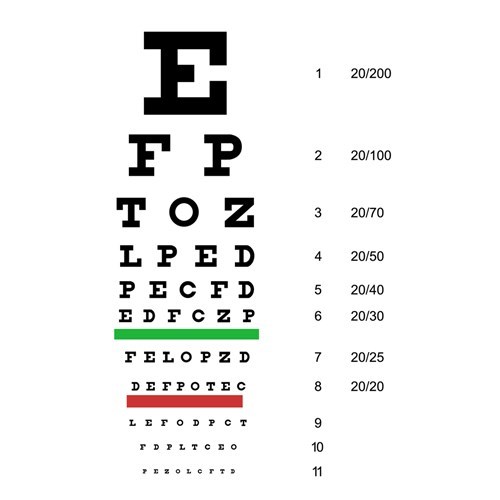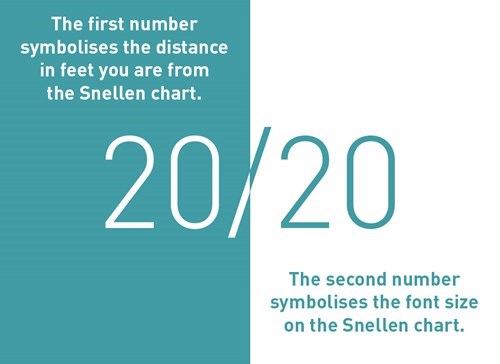Visual Acuity: What is 20/20 Vision?
29 May 2019

Visual acuity is a medical term which refers to clarity or sharpness of vision.
There are three major factors that determine someone’s visual acuity, both physical and neurological. These are:
- How accurately light is focused onto the retina.
- The sensitivity of the vision centres in the brain.
- The ability of the brain to interpret information received through the optical nerve.
A Snellen chart is used to determine visual acuity (the black and white eye chart, containing 11 rows of capital letters, used by opticians).
Visual acuity will not accurately measure quality of vision in every situation however. For example, it cannot measure how well you will see:
- Objects that are alike in brightness to their background.
- Coloured objects.
- Moving objects.

What does 20/20 vision mean?
You hear it on the TV and within magazine articles all the time, but 20/20 vision is a term that often goes misunderstood.
Many people believe that 20/20 vision translates to ‘perfect’ vision- but what does ‘perfect’ vision really mean?
You may be interested to know that in actual fact 20/20 vision means average sharpness of sight. An individual who can identify the standardised 20 font letters on a Snellen chart from 20 feet away equates to 20/20 (normal) vision.
Around 75% of adults possess 20/20 vision; but it is possible to achieve better than 20/20 vision.
If an individual, for example, can read font 10 from a Snellen chart from 20ft away, they would have a visual acuity of 20/10. In other words, they have what is considered higher than average visual acuity because they can identify a smaller font size from the same distance, as someone who has 20/20 vision.

How is visual acuity tested?
Visual acuity is measured with a Snellen chart. The Snellen chart was developed in 1862 by a Dutch ophthalmologist named Herman Snellen; as a method to quantify visual acuity and standardise what is considered ‘normal’ vision. Despite general belief, testing visual acuity will not determine an individual’s prescription.
To meet the national driving standard, the individual must have a visual acuity of 6/12. Meaning the driver can read size 12 font from the Snellen chart from 6 metres away.
How to test your visual acuity
If you’d like to find out what your visual acuity is, you will need to book an eye test. It is advised that everyone attend an eye examination every two years. These can be arranged with your local optician and should last no longer than 30 minutes.
If you’d like more information regarding the ins and outs of an eye test, you can read our article here.
Along with this you will be given your prescription and if you require visual aids (glasses and contact lenses).
There are alternatives to wearing visual aids, such as:
- Laser Eye Surgery
- Refractive Lens Exchange
- Implantable Contact Lenses
Back to Blog
